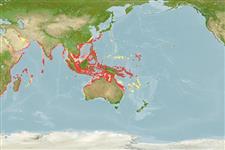>
Eupercaria/misc (Various families in series Eupercaria) >
Gerreidae (Mojarras)
Etymology: Gerres: Latin, gerres = a kind of anchovies; cited by Plinius.
More on author: Cuvier.
Environment: milieu / Klimaatzone / Diepte / distribution range
Ecologie
marien; zoet water; brak water demersaal; amfidroom (Ref. 51243); diepte 1 - 50 m (Ref. 4372). Tropical; 26°C - 29°C (Ref. 4959); 32°N - 35°S, 25°E - 171°E
Indo-West Pacific: East Africa and Madagascar to Japan and Australia; New Caledonia (Ref. 26587) and Vanuatu (Ref. 13300). Enters rivers and lakes in Madagascar and the east coast of Africa. Not in the Middle East (Ref. 103159).
Lengte bij maturiteit / Grootte / Gewicht / Leeftijd
Maturiteit: Lm 19.0 range ? - ? cm
Max length : 39.0 cm TL mannelijk / geslacht onbekend; (Ref. 116875); common length : 15.0 cm SL mannelijk / geslacht onbekend; (Ref. 4967); max. gerapporteerde leeftijd: 8 Jaren (Ref. 116875)
Dorsale stekels (totaal) : 9; Dorsale zachte stralen (totaal) : 10 - 11; Anale stekels: 2 - 3; Anale zachte stralen: 7 - 8.
Body shape (shape guide): fusiform / normal; Cross section: compressed.
Adults are coastal inhabitants found on soft bottoms (Ref. 44894), over sandy substrate (Ref. 12693). Juveniles are found in brackish mangrove estuaries, sometimes enter fresh water (Ref. 2847, 44894), lakes (Ref. 4323), tidal creeks (Ref. 44894) and lower freshwater reaches of rivers (Ref. 12915). Feed on small crustaceans, polychaetes and forams on sand or muddy-sand bottoms (Ref. 12915), worms and insect larvae (Ref. 12693). Length at first reproduction was reported to be around 12 cm SL, for a population in a South African estuary (D. Woodland, pers.comm. 07/13). Salted or made into fish sauce.
Juveniles enter estuaries and mangrove areas at 1 cm SL and stay until they reach maturity, at which stage they move out to sea (Ref. 36558).
Woodland, D.J., 1984. Gerreidae. In W. Fischer and G. Bianchi (eds.) FAO species identification sheets for fishery purposes. Western Indian Ocean fishing area 51. Vol. 2. [pag. var.]. FAO, Rome. (Ref. 3409)
Status op de Rode Lijst van het IUCN (Ref. 130435: Version 2025-1)
Gevaar voor de mens
Harmless
Gebruik door de mens
Visserij: van minder commercieel belang
Tools
Speciale rapporten
Download XML
Internetbronnen
Estimates based on models
Preferred temperature (Ref.
123201): 24.8 - 29.1, mean 28.2 °C (based on 1220 cells).
Fylogenetische diversiteitsindex (Ref.
82804): PD
50 = 0.5000 [Uniqueness, from 0.5 = low to 2.0 = high].
Bayesian length-weight: a=0.01230 (0.01001 - 0.01512), b=3.05 (3.01 - 3.09), in cm total length, based on LWR estimates for this species (Ref.
93245).
Trofisch niveau (Ref.
69278): 3.3 ±0.2 se; based on diet studies.
Weerstandsvermogen (Ref.
120179): Gemiddeld, minimale populatieverdubbelingstijd 1,4-4,4 jaar (K=0.3-2.7; tmax=8;).
Fishing Vulnerability (Ref.
59153): Low to moderate vulnerability (32 of 100).
🛈
Nutrients (Ref.
124155): Calcium = 140 [77, 253] mg/100g; Iron = 1 [1, 2] mg/100g; Protein = 18.7 [16.8, 20.5] %; Omega3 = 0.24 [0.13, 0.42] g/100g; Selenium = 47.4 [26.5, 88.1] μg/100g; VitaminA = 18.7 [5.9, 46.9] μg/100g; Zinc = 1.42 [0.97, 1.98] mg/100g (wet weight);
